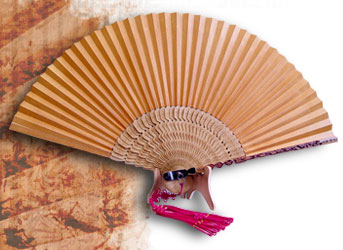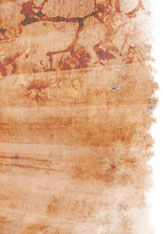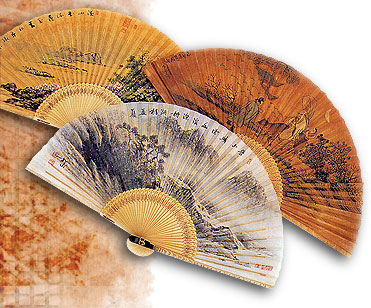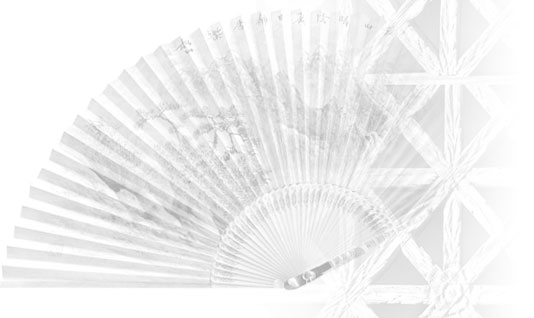 The sounds of a breeze awakening a bamboo forest and a stream flowing through a valley were The sounds of a breeze awakening a bamboo forest and a stream flowing through a valley were
 often glorified as the sounds of nature in Korean poems of old. These verses praised the lovely
often glorified as the sounds of nature in Korean poems of old. These verses praised the lovely
 rustling sound bamboo leaves make whenever the wind blows through a dense stand of
rustling sound bamboo leaves make whenever the wind blows through a dense stand of
 bamboo, sounds that are delightfully fresh and cool. It is these delicate whispers that
bamboo, sounds that are delightfully fresh and cool. It is these delicate whispers that
 Korean folding fans possess within them.
Korean folding fans possess within them.
 Bamboo has a personality that defies any touch of warmth or any attempt to rid it of Bamboo has a personality that defies any touch of warmth or any attempt to rid it of
 its composed coolness. A Korean fan is made of paper-thin bamboo strips covered
its composed coolness. A Korean fan is made of paper-thin bamboo strips covered
 with paper or silk after they have been spread in a circular or semi-circular form. Traditional
with paper or silk after they have been spread in a circular or semi-circular form. Traditional
 Korean paper fans are largely divided into two types according to their shape: a round fan (dandeon) and a
Korean paper fans are largely divided into two types according to their shape: a round fan (dandeon) and a
 folding fan (jeopseon). According to Korean tradition, the former is usually used by women whereas
folding fan (jeopseon). According to Korean tradition, the former is usually used by women whereas
 the latter by men. The folding fan is called hapjukseon in Korea, which literally means 'joined bamboo
the latter by men. The folding fan is called hapjukseon in Korea, which literally means 'joined bamboo
 fan.' Seonjajang, or Master Craftsman of Fan Making, Yi Gi-dong is a master artisan of hapjukson.
fan.' Seonjajang, or Master Craftsman of Fan Making, Yi Gi-dong is a master artisan of hapjukson.
Korean art historians believe that the folding fan was invented by a Buddhist monk during the Goryeo Dynasty
(918-1392), before it spread as far as Europe through China and Japan. An emperor of the Northern Sung Dynasty was
fascinated by the beauty and ingenuity of Goryeo folding fan and decided that the Goryeoseon ('Goryeo Fan'), as he
named it, should be made in China, too. Seo Geung, who was a Sung envoy to the Goryeo Dynasty, wrote in his
encyclopedic book, Goryeo Dogyeong ("An Illustrated Book of Goryeo") that, “Goryeo people carry a fan even in mid-winter,
and its design of folding and unfolding is very original.” Records show that this folding type of Goryeo hand fan was something
that foreigners had never seen before.
A closer look at a hapjukseon fan reveals that it has the form of a woman’s body. According to legend, the Goryeo monk
who made the first hapjukson was in love with a woman that he, as a Buddhist priest, could never have. He strived to be
faithful in his quest for the absolute truth and for nirvana but could not succeed because of his passionate emotions
towards her. In the end, the monk decided to make a fan in the shape of the woman of his heart. He made the ribs of the
fan with carefully cut bamboo strips and covered them with mulberry paper, which had a poem written on it. When he folded
 the fan, the figure of the beautiful woman appeared before his eyes, complete with the head
the fan, the figure of the beautiful woman appeared before his eyes, complete with the head
 (the part held with the hands) ornamented with a hairpin (a metal piece joining the bamboo strips),
(the part held with the hands) ornamented with a hairpin (a metal piece joining the bamboo strips),
 bosom (the gently protruding part under the head) and the loose-fitting skirt that spreads
bosom (the gently protruding part under the head) and the loose-fitting skirt that spreads
 beautifully when the fan is unfolded. A bat design inscribed on the bamboo ribs symbolizes
beautifully when the fan is unfolded. A bat design inscribed on the bamboo ribs symbolizes
 the secret meeting of a man and woman at night, like this nocturnal animal, while the
the secret meeting of a man and woman at night, like this nocturnal animal, while the
 design of a chrysanthemum represents a woman's fidelity, like an elegant
design of a chrysanthemum represents a woman's fidelity, like an elegant
 chrysanthemum opening its graceful fragrant blossom despite the late autumn frost.
chrysanthemum opening its graceful fragrant blossom despite the late autumn frost.
 Traditional Korean hand fans have been highly regarded by Japanese, Chinese and Traditional Korean hand fans have been highly regarded by Japanese, Chinese and
 even Western countries for their fine-quality materials, artistic originality and tasteful even Western countries for their fine-quality materials, artistic originality and tasteful
 decorations. An first-rate Korean hand fan usually consists of a beautiful landscape; a decorations. An first-rate Korean hand fan usually consists of a beautiful landscape; a
 bird-and-flower painting or a poem written in a graceful calligraphic style on paper; bird-and-flower painting or a poem written in a graceful calligraphic style on paper;
 the ribs elaborately inscribed with various nakjuk (pyrography) designs of symbolic the ribs elaborately inscribed with various nakjuk (pyrography) designs of symbolic
 animals or plants such as bats, chrysanthemums and maehwa; and the head decorated animals or plants such as bats, chrysanthemums and maehwa; and the head decorated
 with an exquisite maedeup (decorative knotting) pendant with jade, amber, gold with an exquisite maedeup (decorative knotting) pendant with jade, amber, gold
 ornaments, an incense bag, sundial or yundo compass, all creating a wonderful harmony with its
ornaments, an incense bag, sundial or yundo compass, all creating a wonderful harmony with its
 delightful lines and unique forms that can be rarely seen anywhere else in the world.
delightful lines and unique forms that can be rarely seen anywhere else in the world.
The main function of a Korean paper fan is to create a cool breeze to diffuse the heat of a summer's day, but it has many other
important functions as well. It has been used as a screen to hide the fan-holder's face from people or from the sun’s scorching
rays, as a weapon for self-defense, and as the main prop of an entertainer in a performance of pansori or other traditional
performing art. It has also been an essential implement and symbol of love of Korean mothers who try to keep annoying
insects such as mosquitoes or flies away from their children, who have fallen into sweet sleep on a hot afternoon.
View the master's works
|




















